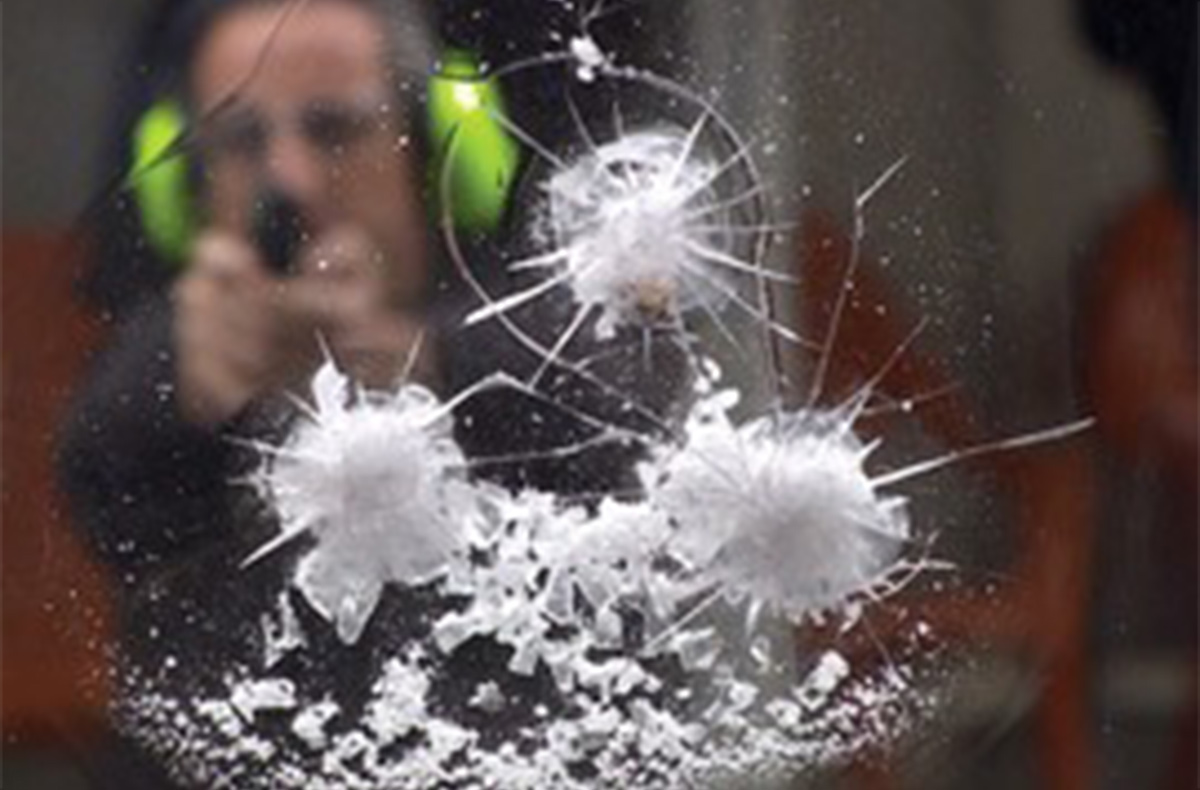Safety first:
Considerations for performance plastics materials in security equipment
security
lastics are widely used in environments requiring safety and security because they are durable, lightweight and resistant to corrosion. Additionally, plastics can be molded into various shapes, making them versatile for applications such as bulletproof glass, security barriers and protective gear. Their ability to withstand harsh conditions and provide impact resistance contributes to their widespread use in security-related products.
To qualify as bullet-resistant, plastics undergo rigorous testing based on industry standards. Some key testing criteria include:
Velocity and caliber requirements: Materials are tested against specific bullet velocities and calibers to ensure they can effectively resist penetration. Different levels of protection may require withstanding different bullet types and speeds.
Deformation: This measures the extent to which the material deforms upon impact. Minimal backface deformation is crucial to prevent injury behind the armor.
Environmental factors: Plastics may be tested for their performance under various environmental conditions, including temperature extremes and humidity, to ensure their durability.
Fragmentation resistance: Ensuring that the material minimizes the risk of producing sharp or hazardous fragments upon impact is essential for user safety.
Multi-hit capability: The ability of the material to withstand multiple impacts in close proximity is a critical factor for security equipment in real-world scenarios.
Meeting these criteria helps ensure that the ballistic-rated plastics provide reliable protection against a range of ballistic threats.
Polycarbonate offers advantages in security applications like armored vehicles, police shields and vehicle windows due to its exceptional strength, impact resistance and clarity. It provides protection against ballistic threats while maintaining visibility and is lighter than traditional materials, contributing to improved fuel efficiency in vehicles. Additionally, polycarbonate’s durability and resistance to shattering make it a valuable choice for ensuring the safety of occupants in high-risk situations.
Police car interior barriers using plastics, like polycarbonate, provide a transparent and durable shield, adding an extra layer of protection for officers. These barriers help prevent physical contact with suspects in the back seat and enhance overall safety during transportation.
Kevlar bulletproof vests offer lightweight, flexible protection against ballistic threats by absorbing and dispersing impact energy. They are widely used by law enforcement and military for enhanced safety without sacrificing mobility.

Advancements in armored vehicles have seen the integration of various materials to enhance protection while minimizing weight. Plastics, particularly high-strength composites, have been increasingly utilized in armored vehicle construction for their advantageous properties:
Weight-savings: Compared to traditional metal armor, plastics and composite materials are lighter, enabling better mobility and fuel efficiency without compromising protection.
Durability: Advanced plastics and composite materials can offer impressive strength and durability, with some varieties being as strong as or even stronger than steel while being significantly lighter.
Design flexibility: Plastics allow for more flexibility in design, enabling manufacturers to create complex shapes that optimize protection and aerodynamics.
Resistance to corrosion: Unlike metals, certain plastics are more resistant to corrosion and degradation, ensuring a longer lifespan for armored vehicles.
Cost efficiency: In some cases, composite materials can be more cost-effective than traditional materials due to their lower weight and reduced need for maintenance.
However, challenges such as heat resistance, ballistic performance and cost-effectiveness in large-scale production remain considerations for widespread adoption. Nonetheless, ongoing research and development aim to address these challenges, pushing the boundaries of what’s possible in armored vehicle construction using plastic and composite materials.
In security applications, the choice between plastic and glass often depends on the specific requirements of the application. For instance, bulletproof glass might incorporate laminated glass layers or polycarbonate layers, combining the strengths of both materials to create a composite material that offers both transparency and ballistic resistance. Bulletproof glass made with laminated polycarbonate is used in prison and detention center glazing, armored vehicles, banks, jewelry stores, schools, government buildings, security checkpoints and other high-security locations where protection against firearms or explosions is crucial.
Compared to traditional glass, laminated polycarbonate is lighter, making it easier to handle and install in various applications.
Here are some additional key features of laminated polycarbonate:
Layered construction: Laminated polycarbonate consists of multiple layers of polycarbonate material bonded together with interlayers, often made of aliphatic polyurethane or ethylene vinyl acetate (EVA).
Ballistic resistance: The layers work synergistically to absorb and disperse the energy of impacts, preventing bullets or projectiles from penetrating through the entire thickness of the material.
Protection levels: Laminated polycarbonate can be engineered to meet specific ballistic standards set by organizations like the National Institute of Justice (NIJ) or other international standards. These standards dictate the level of protection against different types and calibers of ammunition.

Laminated polycarbonate can be customized in terms of thickness, number of layers and additional coatings, such as an abrasive resistant coating to meet specific protection requirements. Laminated polycarbonate’s ability to combine transparency, light transmission, strength and ballistic resistance makes it an ideal choice for applications where both protection and visibility are essential.
While plastics offer several advantages, it’s important to note that the choice of materials for riot shields and body armor depends on the intended use, level of protection needed and the specific threats they are designed to counter. Some advanced body armors also incorporate a combination of materials, such as ceramic plates within a plastic matrix, to optimize protection while maintaining lightweight properties.
Tony Martin is Business Unit Manager for Palram Americas, Inc. For more information, contact Palram Americas, Inc at Arcadia West Industrial Park, 9735 Commerce Circle, Kutztown, PA 19530-8579, USA, or by phone at (610) 285-9918, fax at (610) 285-9928, email at contactus.usa@palram.com or www.palram.com/us.